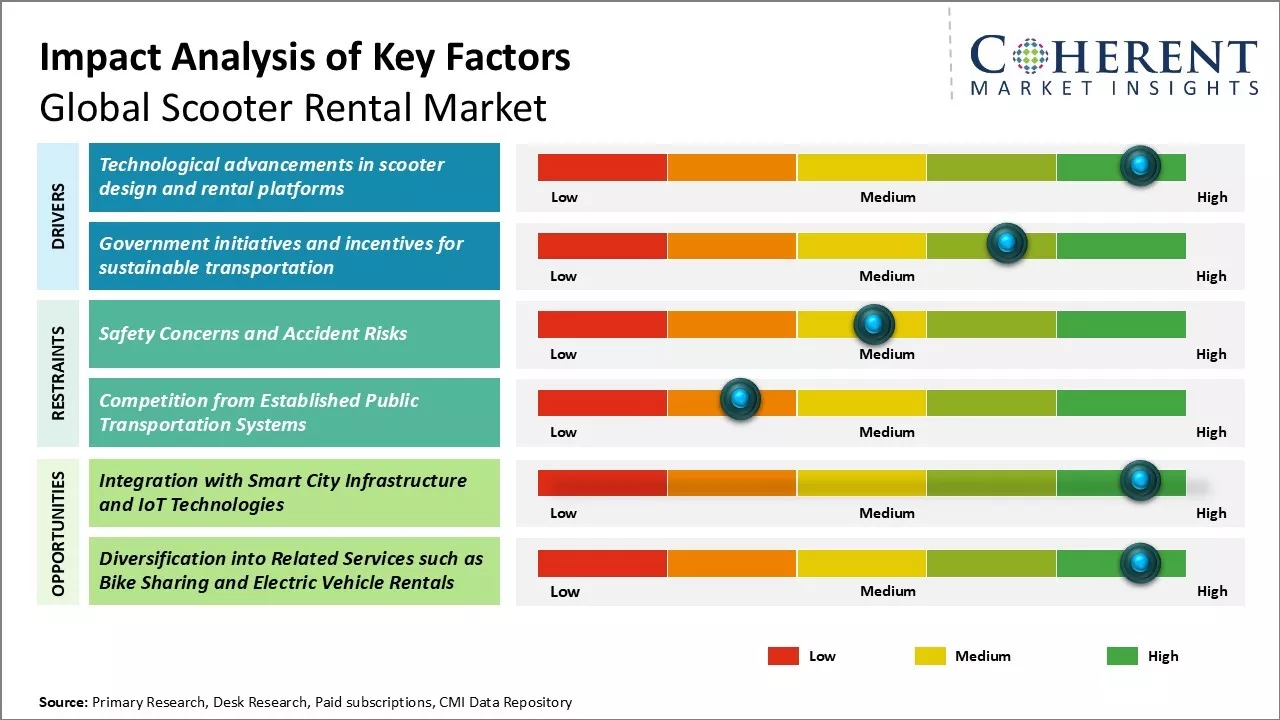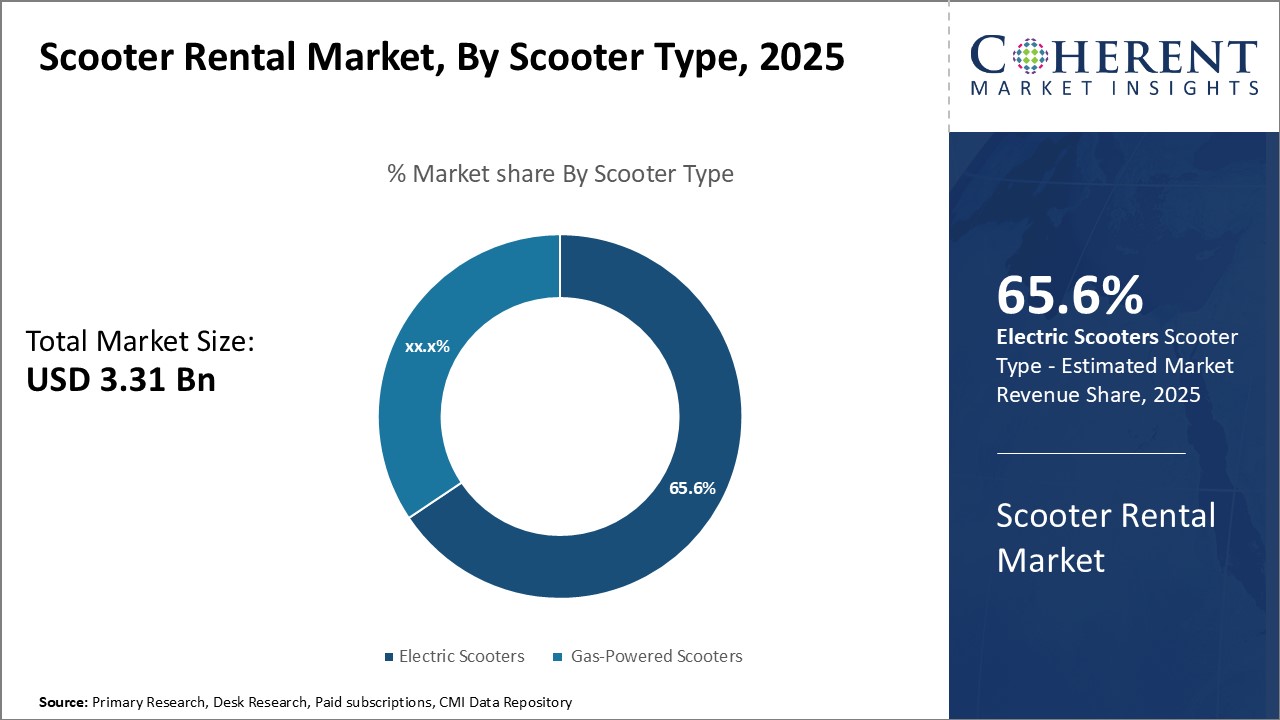The global scooter rental market is estimated to be valued at USD 3.31 Billion in 2025 and is expected to reach USD 9.58 Billion by 2032, exhibiting a compound annual growth rate (CAGR) of 16.4% from 2025 to 2032.

Discover market dynamics shaping the industry: Request sample copy
Scooter rental services have grown in popularity in recent years as an affordable and convenient mode of transport for urban commutes and tourism activities. The Scooter Rental Market has witnessed a steady rise in new entrants and service expansions across major cities globally.
Market Driver - Technological advancements in scooter design and rental platforms
In recent times, there have been significant technological advancements in the design of electric scooters as well as platforms that enable efficient rental operations. On the design front, scooters now come equipped with larger batteries that allow for longer range per charge. This enhanced range helps address consumer range anxiety and has increased the scope of rides. Scooters are also becoming increasingly intelligent with features like GPS, IoT connectivity and geo-fencing capabilities. This allows rental providers to efficiently track and monitor their fleet, ensure riders follow local rules, and remotely operate locks if needed.
Some rental companies have also introduced innovative locking and payment mechanisms into their scooters. Features like app-based unlocking using Bluetooth or NFC tags and digital payment options through the app improve convenience. Such integrated technologies reduce the need to physically interact with machines for basic operations. This leads to frictionless riding experiences and bodes well for attracting more users. Moreover, many rental providers are moving their backend operations to cloud platforms that help manage real-time availability information, prevent misparking using AI and handle customer services digitally.
Automotive companies have also entered this space and are bringing their expertise in electrification and mass production to develop higher-quality scooters. These players are continuously collaborating with technology firms to build vehicles that are not only efficient to ride but also connectable. For example, integrating e-scooters with smartphone apps allows monitoring ride data and health of vehicles. This collected usage information aids optimizations, predictive maintenance, and safety features over time. Advanced technologies like these make shared e-scooters more reliable and user-friendly, thereby supporting increased adoption.
For instance, in February 2022, Moto Business Service India (MBSI), a subsidiary of Yamaha Motors focused on shared mobility solutions, made a strategic investment in Royal Brothers, a bike rental company. This collaboration operates on a revenue-sharing model and represents MBSI's inaugural partnership as it seeks to enhance its footprint in the shared mobility sector. Additionally, MBSI intends to collaborate with other emerging market players in the future to broaden its service offerings.

Get actionable strategies to beat competition: Request sample copy
Government initiatives and incentives for sustainable transportation
Governments across various cities and countries have proactively introduced initiatives and incentives targeted at promoting micro-mobility and sustainable transportation. For instance, many local administrations provide designated lanes for bikes and e-scooters to encourage their usage for shorter commutes as an alternative to cars or public transport. Authorities also organize awareness drives highlighting environmental benefits and health advantages of greener commute options. This nurtures a culture of adopting micro-mobility aids like e-scooters and e-bikes for daily trips.
Some governments offer tax rebates or purchase subsidies for eco-friendly vehicles including e-scooters. Few cities have launched schemes providing seed funding or infrastructure support for setting up rental fleets of shared e-scooters. Regulatory frameworks are also being developed to accommodate and regulate their usage on roads and public places. Setting clear operational guidelines helps address safety concerns and encourages structured growth of rental businesses.
Certain administrations give preferential parking rights or reduced parking fees for green vehicles. Some nations provide tax breaks to companies investing in manufacturing environmentally sustainable mobility options. A few ambitious nations have even announced nationwide bans on new petrol or diesel vehicles post a deadline with goals to fully transition to electric mobility in the coming decades. Proactive steps like these by governments lay the foundation for an ecosystem promoting the shift to low-carbon transport using innovative solutions like shared electric scooter services.
Key Takeaways from Analyst:
The global scooter rental market holds strong potential for growth over the next five years driven by rising fuel costs, increased traffic congestions in cities, and need for last-mile connectivity will continue supporting the adoption of shared mobility solutions like scooter rentals. However, safety concerns surrounding electric scooter usage and lack of proper infrastructure could limit market expansion.
The North America region currently dominates the global scooter rental market and the trend is expected to continue. Both countries have very high population densities in their cities and increasing ownership of smartphones is boosting the popularity of shared mobility apps. Europe is also emerging as another key market for scooter rentals driven by growing investments from major operators in cities across countries like U.S.
On the other hand, the scooter rental sectors in Asia Pacific is forecasted to witness the fastest growth during the coming years. E-scooters have quickly gained mass adoption in major cities like Spain, Italy as they offer a convenient and affordable transportation option for intra-city travel. Growing investments by Bird, Lime, and other startups in expanding fleets and partnerships with local administrations is supplementing this growth.
Market Challenges: Safety Concerns and Accident Risks
One of the major challenges faced by the global scooter rental market is safety concerns and risks of accidents. As scooter rentals have gained popularity as an affordable and flexible transportation option in many cities, there have been growing incidents of unsafe riding and traffic accidents. Many riders do not wear proper safety gear like helmets which can lead to serious injuries in case of accidents. There is also a lack of enforcement of traffic rules by many scooter rental users which increases recklessness. This has led to an adverse impact on public perception regarding the safety of shared electric scooters. Unless the operators take proactive measures to promote safety through compulsory training and enforcement of traffic laws, these safety issues can negatively impact the future growth potential of scooter rentals in many emerging markets. The companies must work closely with local authorities to set strict safety protocols and penalties to mitigate accident risks which is a major roadblock for the wider acceptance of this new transportation trend.
Market Opportunities: Integration with Smart City Infrastructure and IoT Technologies
One of the major opportunities for the global scooter rental market is the potential to integrate with smart city infrastructure and utilize Internet of Things (IoT) technologies. As many cities worldwide are implementing smart and connected technologies to improve urban transportation systems, scooter rentals can leverage these developments. The scooters can be equipped with sensors and IoT devices to allow predictive maintenance, smart parking through integration with city maps and enable contactless payment. This will enhance user experience through features like live tracking and improved battery performance. The data captured from these connected scooters can help operators and city planners to analyze traffic and commuting patterns for better urban planning. As more cities become digitally enabled, the scope of deploying shared electric scooters as part of smart and sustainable mobility solutions will drive considerable growth in the scooter rental market over the coming years.

Discover high revenue pocket segments and roadmap to it: Request sample copy
Insights By Scooter Type - The Rising Popularity of Electric Vehicles Drives the Electric Scooters Segment
In terms of scooter type, the electric scooters segment is estimated to dominate the market revenue share, accounting for 65.6% in 2025 owing to several key factors. Electric scooters offer many benefits over gas-powered variants. They are more environment-friendly as they produce zero direct emissions. This has become a major decision-making factor for many customers as environmental protection gains increasing importance globally. Electric scooters also have lower maintenance costs than gas vehicles. They do not require oil changes or engine tune-ups, reducing total cost of ownership. Furthermore, electricity is often more affordable per kilometer than gas over the long run.
Electric scooters provide a smoother and more comfortable riding experience than gas scooters. They accelerate faster and operate more quietly without the noise and vibrations of a combustion engine. This makes them well-suited for urban riding in busy cities. With a reliable guaranteed range of up to 60 km on a full charge, electric scooters meet the needs of many rental customers. Convenience of recharging at home or public charge points is another advantage. Given these benefits, it is unsurprising that electric scooters dominate the market for short-term rental fleets.
Insights By Power - Convenience and Affordability Drive Less than 3 kW Scooter Preference
In terms of power, the less than 3 kW segment is estimated to contribute 52.2% share of the market in 2025. Scooters in this power range provide the perfect balance of performance and affordability that meets the needs of most rental customers. Scooters below 3 kW are ideal for short urban hops around neighborhoods, university campuses and city centers. Their lighter weight and smaller size relative to more powerful models make them easy to handle and store. Short battery recharge times allow frequent rental turnover.
Furthermore, lower power scooters require simpler technology and have lower manufacturing costs. This cost-saving is passed on to customers through affordable rental rates. With performance adequate for basic commuting needs, Less than 3 kW scooters offer the best value proposition. Their hassle-free convenience in renting for a few hours makes them attractive for weekday grocery trips or weekend joyrides alike. Ease of operation ensures safe navigation for inexperienced riders. Overall simplicity and affordability drive strong demand for this power segment.
Insights By Application - Tourism Boosts Scooter Rentals for Last-Mile Travel and Experience
In terms of application, the tourism segment is estimated to contribute 46.8% share of the market in 2025. Rental scooters have become a popular option for last-mile travel and exploration among tourists. They provide a fun, quick and inexpensive way to get around busy city destinations independently. Unlike buses or taxis, scooters allow flexibility to travel at one's own pace and avoid overcrowded routes. Affordable daily or weekly rental packages expand visitors’ mobility radius beyond public transport limits.
Visiting unfamiliar areas on a scooter also creates a more immersive local experience than passive transportation. Riding through historic neighborhoods, along waterfront promenades and amidst bustling markets gives a feel of a place that cannot be achieved from car or train windows. Two-wheeling allows tourists to better sense a location's unique atmosphere. The thrill of navigating roads like the locals further enhances the adventure of travel. Availability of eco-friendly electric models also lets visitors contribute to environmental protection of their holiday spots. Overall, scooter rentals play a big role in satisfying tourism demand for affordable yet enriching last-mile connectivity and cultural exploration.

Need a Different Region or Segment? Customize now
North America dominates the global scooter rental market. The region is expected to hold a market revenue share of 40.6% in 2025. Scooters are an integral part of urban transportation infrastructure in these countries and their extensive road networks, dense cities and mild climates make them perfectly suited for scooter travel. Further, local authorities have actively promoted shared micro-mobility solutions like scooter rentals to reduce traffic congestion and pollution. As a result, major scooter rental operators like Lime, Bird and Voi have a strong presence across major European cities with large fleets. Rapid inter-city and intra-city connectivity in Europe also ensures scooter rentals witness steady demand throughout the year.
Meanwhile, the Asia Pacific region is emerging as the fastest growing market for scooter rentals. Countries like China, India, Indonesia, and Vietnam are experiencing exponentially rising urbanization alongside rapidly expanding middle-class populations with increasing disposable incomes. Given Asia Pacific's hot and humid climates for most parts of the year, electric scooters are proving to be popular alternatives to other modes of transportation. Since many Asian cities are notoriously overcrowded with traffic, local authorities are incentivizing micro-mobility services like electric scooter rentals for short commutes. Major fleets operators from Europe as well as regional startups are aggressively expanding their footprints across major Asian cities. While the usage of such services is still in a nascent stage compared to developed markets, Asia Pacific is primed for strong adoption in the coming years led by rapid digitization and young demographic profiles.
Scooter Rental Market Report Coverage
| Report Coverage | Details | ||
|---|---|---|---|
| Base Year: | 2024 | Market Size in 2025: | USD 3.31 Bn |
| Historical Data for: | 2020 To 2024 | Forecast Period: | 2025 To 2032 |
| Forecast Period 2025 to 2032 CAGR: | 16.4% | 2032 Value Projection: | USD 9.58 Bn |
| Geographies covered: |
|
||
| Segments covered: |
|
||
| Companies covered: |
Bird Rides, Inc., Bolt, Circ, Dott, Lime, LimeBike, Lyft, Inc., Massive Mobility, Pony, Razor USA LLC, Scoot Networks, Spin, Superpedestrian, TIER Mobility, and Voi Technology |
||
| Growth Drivers: |
|
||
| Restraints & Challenges: |
|
||
Uncover macros and micros vetted on 75+ parameters: Get instant access to report
*Definition: The global scooter rental market involves electric scooter rental services provided across different cities globally. Major players in this market operate dockless scooter-sharing systems that allow users to locate, unlock and pay for scooters using a smartphone app. Users can pick up a scooter from any public place and park it at their destination, helping reduce dependency on personal vehicles. The scooter rental market is growing rapidly as more cities embrace shared micro-mobility solutions to tackle issues like traffic congestion.
Share
Share
About Author
Gautam Mahajan is a Research Consultant with 5+ years of experience in market research and consulting. He excels in analyzing market engineering, market trends, competitive landscapes, and technological developments. He specializes in both primary and secondary research, as well as strategic consulting across diverse sectors.
Missing comfort of reading report in your local language? Find your preferred language :
Transform your Strategy with Exclusive Trending Reports :
Frequently Asked Questions
Joining thousands of companies around the world committed to making the Excellent Business Solutions.
View All Our Clients
US Reciprocal Tax Impact Analysis On Scooter Rental Market
Stay updated on tariff changes with expert insights and timely information